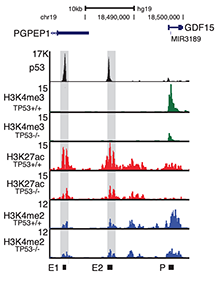This manuscript was originally described in Catizone AN et al bioRxiv 2019
Abstract
The master tumor suppressor p53 controls transcription of a wide-ranging gene network involved in apoptosis, cell cycle arrest, DNA damage repair, and senescence. Recent studies revealed pervasive binding of p53 to cis-regulatory elements (CRE), which are non-coding segments of DNA that spatially and temporally control transcription through the combinatorial binding of local transcription factors (TFs). Although the role of p53 as a strong trans-activator of gene expression is well known, the co-regulatory factors and local sequences acting at p53-bound CREs are comparatively understudied. We designed and executed a massively parallel reporter assay (MPRA) to investigate the effect of transcription factor binding motifs and local sequence context on p53-bound CRE activity. Our data indicate that p53-bound CREs are both positively and negatively affected by alterations in local sequence context and changes to co-regulatory TF motifs. We identified a SP1/KLF family motif located in an intronic p53 CRE that is required for the endogenous expression of the p53-dependent gene CCNG1. We also identified ATF3 as a factor that co-regulates the expression of the p53-dependent gene GDF15 through binding with p53 in an upstream CRE. Loss of either p53 or ATF3 severely reduces CRE activity and alters endogenous GDF15 mRNA levels in the cell. Our data suggests that p53 has the flexibility to cooperate with a variety of transcription factors in order to regulate CRE activity. By utilizing different sets of co-factors across CREs, we hypothesize that p53 activity is guarded against loss of any one regulatory partner allowing for dynamic and redundant control of p53-mediated transcription.
